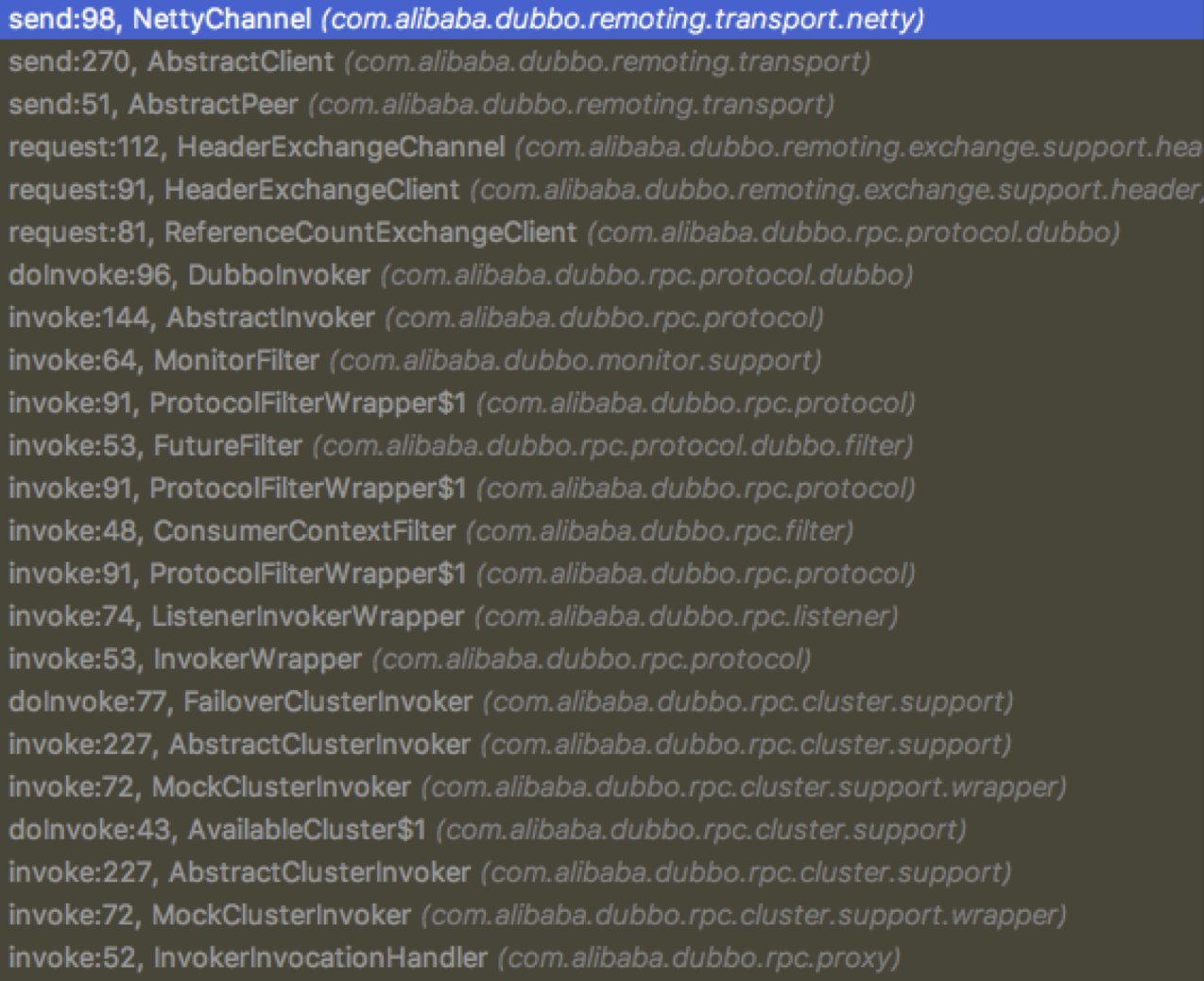dubbo的远程调用过程是怎么样的?
dubbo远程过程调用经过了那些处理?
发起远程调用的时候究竟传了什么数据给provider?
要解决这些问题,欢迎一起探讨走进dubbo源码栏目。
在service reference中说了consumer端发起调用的时候使用的是远程服务的本地代理,发起调用的堆栈是

(上面调用堆栈中的filter链先不介绍了,留在后面service reply中介绍,因为consumer和provider的filter链构造过程是类似的)
前面说过consumer在引用服务的时候最终会生成一个proxy,该proxy是实现了对应的服务接口(比如:com.test.service.TestDubboService),而且包含一个InvokerInvocationHandler属性,在proxy的服务接口方法中调用InvokerInvocationHandler.invoke
public Object invoke(Object proxy, Method method, Object[] args) throws Throwable {
String methodName = method.getName();
Class<?>[] parameterTypes = method.getParameterTypes();
// 判断是否是Object的方法,如果是则直接执行本地调用,不发起远程调用
if (method.getDeclaringClass() == Object.class) {
return method.invoke(invoker, args);
}
// toString、hashCode、equals执行本地调用
if ("toString".equals(methodName) && parameterTypes.length == 0) {
return invoker.toString();
}
if ("hashCode".equals(methodName) && parameterTypes.length == 0) {
return invoker.hashCode();
}
if ("equals".equals(methodName) && parameterTypes.length == 1) {
return invoker.equals(args[0]);
}
// RpcInvocation是一个很重要的类,是真正在consumer和provider之间通过网络传输的实体,里面包含了服务调用需要的必要信息
RpcInvocation invocation = new RpcInvocation(method, args);
Result r = null;
try {
r = invoker.invoke(invocation);
Object o = r.recreate();
return o;
} catch (Throwable e) {
// ... 省略中间代码
}
}
public class RpcInvocation implements Invocation, Serializable {
private static final long serialVersionUID = -4355285085441097045L;
// 调用的方法全限定名
private String methodName;
// 方法的参数类型
private Class<?>[] parameterTypes;
// 入参
private Object[] arguments;
// 附件,可以传递一些其他信息
private Map<String, String> attachments;
// invoker
private transient Invoker<?> invoker;
// ... 省略中间代码
}
上面通过invoke调用发起invoker的调动链,依次调用invoker.invoke方法
MockClusterInvoker#invoke
invoke方法里面会判断是否配置了mock参数
- 如果没有配置则直接继续调用invoke
- 如果配置的值以force开头,表明直接mock调用
- 如果mock配置了但是不以force开头,要先试试正常调用,如果正常调用失败了才会使用mock
AbstractClusterInvoker#invoke
这里继续正常情况下的非mock调用。其实上面接下来调用的是FailbackClusterInvoker#invoke,但是FailbackClusterInvoker继承了AbstractClusterInvoker,而且FailbackClusterInvoker没有实现invoke方法,所以直接调用了超类的invoke方法
- 判断当前Invoker是否被销毁,如果销毁直接抛出异常
- 然后调用directory.list找出所有的invoker
- 通过SPI加载负载均衡的扩展
- 调用实现类的doInvoke
FailbackClusterInvoker#doInvoke
这个类是负责dubbo调用失败重试的类
- 首先检查是否有可以调用的invoker
- 调用AbstractClusterInvoker.select,通过路由到一个指定invoker
- 通过路由到的invoker发起调用
- 如果调用抛出异常了,将请求加入失败列表然后定时重试
上面invoker链调动完之后,会调用dubbo的filter链
// dubbo有一个调用上下文RpcContext,这个filter就是负责往context写信息
com.alibaba.dubbo.rpc.filter.ConsumerContextFilter
// dubbo支持事件通知(oninvoke,onreturn,onthrow),通过该filter实现,
com.alibaba.dubbo.rpc.protocol.dubbo.filter.FutureFilter
// 负责调用过程的监控,调用耗时、并发数等
com.alibaba.dubbo.monitor.support.MonitorFilter
前面部分都是前置处理,开始通过网络向远程发起调用是DubboInvoker.doInvoke方法
protected Result doInvoke(final Invocation invocation) throws Throwable {
RpcInvocation inv = (RpcInvocation) invocation;
final String methodName = RpcUtils.getMethodName(invocation);
// 往invocation的attachments中写入path和version参数
inv.setAttachment(Constants.PATH_KEY, getUrl().getPath());
inv.setAttachment(Constants.VERSION_KEY, version);
ExchangeClient currentClient;
if (clients.length == 1) {
currentClient = clients[0];
} else {
// 因为dubbo支持多个client连接同一个provider,也就是是同一个provider多个连接connections,所以可能是有多个client
currentClient = clients[index.getAndIncrement() % clients.length];
}
try {
// 是否是异步调用,异步调用通过RpcContext.getContext().getFuture().get()来获取结果
boolean isAsync = RpcUtils.isAsync(getUrl(), invocation);
// Oneway:单向调用,调用方只管发起调用,不需要知道返回值,直接返回
// Twoway:双向调用,调用方发起调用后需要知道返回值,需要返回值的情况又分为同步等待或者是异步通知
boolean isOneway = RpcUtils.isOneway(getUrl(), invocation);
// 方法调用的超时时间
int timeout = getUrl().getMethodParameter(methodName, Constants.TIMEOUT_KEY,Constants.DEFAULT_TIMEOUT);
if (isOneway) {
boolean isSent = getUrl().getMethodParameter(methodName, Constants.SENT_KEY, false);
currentClient.send(inv, isSent);
RpcContext.getContext().setFuture(null);
// oneWay只管发送,不关心结果,直接返回
return new RpcResult();
} else if (isAsync) {
ResponseFuture future = currentClient.request(inv, timeout) ;
// 异步调用,直接返回,由future来接收结果,需要结果的时候从future中get
RpcContext.getContext().setFuture(new FutureAdapter<Object>(future));
return new RpcResult();
} else {
// 同步调用
RpcContext.getContext().setFuture(null);
return (Result) currentClient.request(inv, timeout).get();
}
} catch (TimeoutException e) {
throw new RpcException(RpcException.TIMEOUT_EXCEPTION, "Invoke remote method timeout. method: " + invocation.getMethodName() + ", provider: " + getUrl() + ", cause: " + e.getMessage(), e);
} catch (RemotingException e) {
// 这儿的异常是dubbo调用过程中dubbo本身的异常,并不是应用抛出的异常
throw new RpcException(RpcException.NETWORK_EXCEPTION, "Failed to invoke remote method: " + invocation.getMethodName() + ", provider: " + getUrl() + ", cause: " + e.getMessage(), e);
}
}
那究竟最后consumer通过网络向provider传输过去的是什东西呢?下面这个方法属于HeaderExchangeChannel类
public ResponseFuture request(Object request, int timeout) throws RemotingException {
if (closed) {
throw new RemotingException(this.getLocalAddress(), null, "Failed to send request " + request + ", cause: The channel " + this + " is closed!");
}
// create request.
// 这儿的Request就是consumer发送出去的内容,Request.data就是RpcInvocation,也就是说provider通过netty接收到的对象就是Request
Request req = new Request();
req.setVersion("2.0.0");
req.setTwoWay(true);
req.setData(request);
DefaultFuture future = new DefaultFuture(channel, req, timeout);
try{
//
channel.send(req);
}catch (RemotingException e) {
future.cancel();
throw e;
}
return future;
}
至于dubbo中的网络层netty这里就不深入介绍了,netty又是一个很强大的框架,以后专门介绍吧。
总结
至此,前面说的三个问题都解决了。consumer已经向provider发出了请求,接下来就是provider响应请求了。